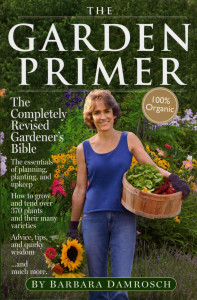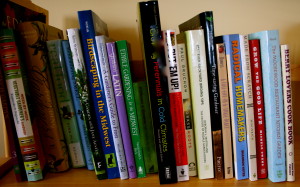Day 31: Best Books for Beginning Vegetable Gardeners
Well, we made it! This is day 31 of our series on how to create and maintain a vegetable garden. We hope this has inspired you to plant vegetables this spring, whether that means a pot of tomatoes on the deck or a community garden plot. We thought we would leave you with a few recommendations for further reading. There are dozens of gardening guides out there, but here are three kinds of books beginners (or an experts) might want to keep in their library.
The Basic Guide
 It’s good to have one book that you can turn to for all your basic vegetable garden questions. This isn’t a book you will necessarily read cover to cover, but one that you will pull off the shelf over and over as you have questions and as your garden skills improve. Three options for this type of book:
It’s good to have one book that you can turn to for all your basic vegetable garden questions. This isn’t a book you will necessarily read cover to cover, but one that you will pull off the shelf over and over as you have questions and as your garden skills improve. Three options for this type of book:
The Garden Primer by Barbara Damrosch runs nearly 700 pages long and has been around since 1988, but it has everything you need to know — and a lot of inside knowledge beyond that — about starting and maintaining a vegetable garden, as well as how-to information on growing 300 different plants.
The Vegetable Gardener’s Bible by Edward Smith is about half the size of Damrosch’s garden primer, but it also offers a good overview of setting up and maintaining vegetables. Smith is a proponent of raised bed gardens and organic methods, a system that’s especially adaptable to urban or smaller yards.
 If you are as interested in cooking and eating as you are in gardening and don’t want too much information at one time, I like the Moosewood Restaurant Kitchen Garden by David Hirsh. The book includes a plant-by-plant section, recipes and a dandy 30-page section in the back with basic information on placing your garden, soil, compost, mulching, and other techniques gardeners need. The book has enough information about everything but not so much you are overwhelmed.
If you are as interested in cooking and eating as you are in gardening and don’t want too much information at one time, I like the Moosewood Restaurant Kitchen Garden by David Hirsh. The book includes a plant-by-plant section, recipes and a dandy 30-page section in the back with basic information on placing your garden, soil, compost, mulching, and other techniques gardeners need. The book has enough information about everything but not so much you are overwhelmed.
A When-to-Do-What Book
A book that tells you when to do what is useful, especially for new vegetable gardeners. There are two good options for northern gardeners.
Month-by-Month Gardening in Minnesota by Melinda Myers offers region-specific advice on when to do various garden chores. The book covers lawn maintenance and perennial and annual gardening as well as vegetables. .
The Week-by-Week Vegetable Gardener’s Handbook by the father-daughter team of Ron and Jennifer Kujawski is a combination calendar/how-to manual. It tells gardeners which specific tasks to do when based on the last frost date for your area.
After you determine your frost-free date, the book asks readers to back up 20 weeks, and from there, provides week-by-week tasks to prepare, plant, weed and harvest a great vegetable garden. Because Minnesota’s season is especially compressed, not every task can be done on the schedule the Kujawskis set out — but when that’s the case, they usually note it. The book is more than a to-do list, however. It offers charts and drawings that show gardeners how to do the tasks, and it provides insights obviously gleaned from years of experience.
Specialty Books
 Depending on your interests, you may want to get a specialty book or two. There are books on herb gardening (Herb Gardening for the Midwest by Debra Knapke and Laura Peters), growing tomatoes (The Great Tomato Book by Gary Ibsen), gardening in small spaces (Square Foot Gardening by Mel Bartholmew) or gardening for a special cuisine (The Edible French Garden by Rosalind Creasy).You can also find books on growing fruit (Growing Fruit Naturally by Lee Reich) and all sorts of vegetable gardening topics.
Depending on your interests, you may want to get a specialty book or two. There are books on herb gardening (Herb Gardening for the Midwest by Debra Knapke and Laura Peters), growing tomatoes (The Great Tomato Book by Gary Ibsen), gardening in small spaces (Square Foot Gardening by Mel Bartholmew) or gardening for a special cuisine (The Edible French Garden by Rosalind Creasy).You can also find books on growing fruit (Growing Fruit Naturally by Lee Reich) and all sorts of vegetable gardening topics.
The MSHS Bookstore has a selection of all kinds of gardening books for beginners and experts. Tell us in the comments some of your favorite titles.

2 Comments
-
Pingback: Tomato Best Vegetable Gardening Books
-
Pingback: Two New Books for Vegetable Gardeners - Minnesota State Horticultural Society
Back to Blog